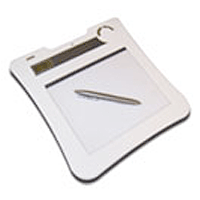
A digitizing tablet is a popular ICT (information and communication technology) based presentation techniques providing alternate option to Digital Interactive Whiteboard.
A digitizing tablet allows to digitize images, graphics, handwritten notes and
navigate computer files acting as a computer input device. A digitizing tablet removes the barrier of staying rooted to one place and gives mobility to move around the classroom while delivering lessons with no more glare from the best projectors. It can be passed around the classroom for the students to navigate to their work, add notes or annotate over resources. Some digitizing tablet have user defined keys, located across the top of the tablet, allowing instant access to various captivating Presentation Tool, such as Annotation Pens, Spotlight and Reveal. The digitizing tablet software also includes a library of clip art images.
A digitizing tablet comprises of two parts, flat surface for drawing graphics and a electronic pen known as ‘stylus’ to draw images on that flat surface. But unlike paper, whatever a user draws on tablet doesn’t appear on its surface. Instead the image appears on the attached computer screen. The accessories which are commonly used with digitizing tablet are: puck, stylus, stylus eraser, tablet mouse, art pen and air brush. A digitizing tablet is connected to a computer through a wireless Radio Frequency interface that plugs into any USB port on the computer. Radio frequency interface allows more than one tablets to be connected to a single system. A digitizing tablet has a grid of wires in the tablet.
When the user writes on the tablet, pen stylus generates electromagnetic signal which is detected by wire grid.